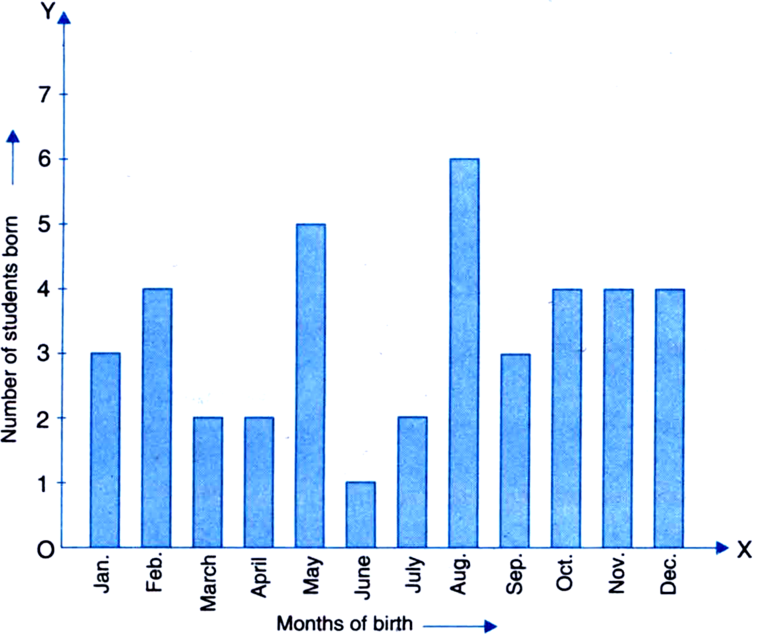
An organisation selected 2400 families at random and surveyed them to determine a relationship between income level and the number of vehicles in a family. The information gathered is listed in the table below:
|
Monthly income |
Vehicles per family |
|||
|
(in र) |
0 |
1 |
2 |
Above 2 |
|
Less than 7000 |
10 |
160 |
25 |
0 |
|
7000-10000 |
0 |
305 |
27 |
2 |
|
10000-13000 |
1 |
535 |
29 |
1 |
|
13000–16000 |
2 |
469 |
59 |
25 |
|
16000 or more |
1 |
579 |
82 |
88 |
Suppose a family is chosen. Find the probability that the family chosen is
(i) earning र 10000–13000 per month and owning exactly 2 vehicles.
(ii) earning र 16000 or more per month and owning exactly l vehicle.
(iii) earning less than र 7000 per month and does not own any vehicle.
(iv) earning र 13000–16000 per month and owning more than 2 vehicles.
(v) owning not more than I vehicle.
Total number of families selected = 2400
(i) Number of families earning र10000–13000 per month and owning exactly 2 vehicles = 29
∴ Probability that the family chosen is earning र10000–13000 per month and owning
exactly 2 vehicles = ![]()
(ii) Number of families earning र16000 or more per month and owning exactly 1 vehicle = 579
∴ Probability that the family chosen is earning र16000 or more per month and owning
exactly 1 vehicle = ![]()
(iii) Number of families earning less than र 7000 per month and does not own any vehicle =10
Probability that the family chosen is earning less than र7000 per month and does not own any vehicle = ![]()
(iv) Number of families earning र13000–16000 per month and owning more than 2 vehicles = 25
∴ Probability that the family chosen is earning र13000–16000 per month and owning
more than 2 vehicles = ![]()
(v) Number of families owning not more than 1 vehicle
= Number of families owning 0 vehicle + Number of families owning 1 vehicle = (10 + 0+ 1 + 2 + 1) +(160 + 305 + 535 + 469 +579) = 14 + 2048 = 2062
∴ Probability that the family chosen owns not more than 1 vehicle = ![]()

Total number of students bom in the year =3+4+2+2+5+1+2+6+3+4+4+4=40
Number of students bom in August = 6
∴ Probability that a student of the class was
born in August = ![]()
Let E be the event of hitting the boundary.
Then,![]()
∴ Probability of not hitting the boundary
= 1 – Probability of hitting the boundary
= 1 – P(E) = 1 – 0.2 = 0.8.
1500 families with 2 children were selected randomly, and the following data were recorded:
|
Number of girls in a family |
2 |
1 |
0 |
|
Number of families |
475 |
814 |
211 |
Compute the probability of a family, chosen at random, having
(0 2 girls (ii) 1 girl (iii) No girl.
Also check whether the sum of these probabilities is 1.
Total number of families
= 475 + 814 + 211 = 1500
(i) Probability of a family, chosen at random,
having 2 girls = ![]()
(ii) Probability of a family, chosen at random,
having 1 girl ![]()
(iii) Probability of a family, chosen at random,
having no girl ![]()
Sum of these probabilities
Hence, the sum is checked.
Three coins are tossed simultaneously 200 times with the following frequencies of different outcomes:
|
Outcome |
3 heads |
2 heads |
1 head |
No head |
|
Frequency |
23 |
72 |
71 |
28 |
If the three coins are simultaneously tossed again, compute the probability of 2 heads coming up.
Total number of times the three coins are tossed = 200
Number of times when 2 heads appear = 72
∴ Probability of 2 heads coming up![]()
